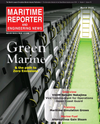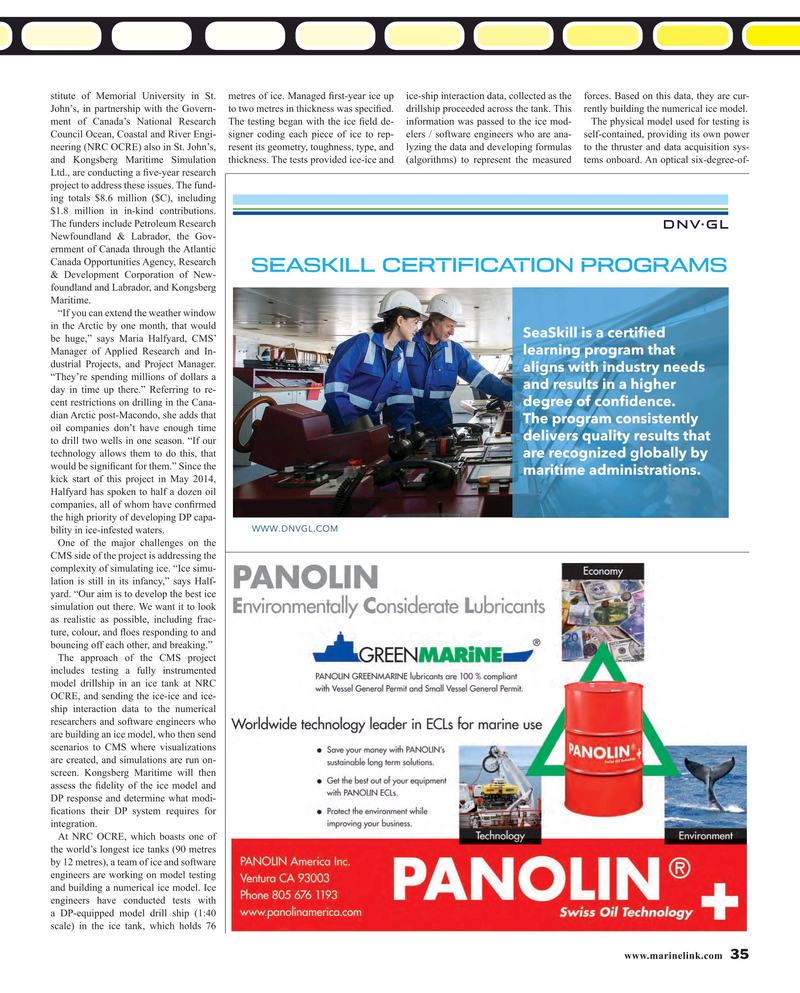
Page 35: of Maritime Reporter Magazine (March 2016)
Green Marine Technology
Read this page in Pdf, Flash or Html5 edition of March 2016 Maritime Reporter Magazine
stitute of Memorial University in St. metres of ice. Managed ? rst-year ice up ice-ship interaction data, collected as the forces. Based on this data, they are cur-
John’s, in partnership with the Govern- to two metres in thickness was speci? ed. drillship proceeded across the tank. This rently building the numerical ice model.
ment of Canada’s National Research The testing began with the ice ? eld de- information was passed to the ice mod- The physical model used for testing is
Council Ocean, Coastal and River Engi- signer coding each piece of ice to rep- elers / software engineers who are ana- self-contained, providing its own power neering (NRC OCRE) also in St. John’s, resent its geometry, toughness, type, and lyzing the data and developing formulas to the thruster and data acquisition sys- and Kongsberg Maritime Simulation thickness. The tests provided ice-ice and (algorithms) to represent the measured tems onboard. An optical six-degree-of-
Ltd., are conducting a ? ve-year research project to address these issues. The fund- ing totals $8.6 million ($C), including $1.8 million in in-kind contributions.
The funders include Petroleum Research
Newfoundland & Labrador, the Gov- ernment of Canada through the Atlantic
Canada Opportunities Agency, Research & Development Corporation of New- foundland and Labrador, and Kongsberg
Maritime.
“If you can extend the weather window in the Arctic by one month, that would be huge,” says Maria Halfyard, CMS’
Manager of Applied Research and In- dustrial Projects, and Project Manager. “They’re spending millions of dollars a day in time up there.” Referring to re- cent restrictions on drilling in the Cana- dian Arctic post-Macondo, she adds that oil companies don’t have enough time to drill two wells in one season. “If our technology allows them to do this, that would be signi? cant for them.” Since the kick start of this project in May 2014,
Halfyard has spoken to half a dozen oil companies, all of whom have con? rmed the high priority of developing DP capa- bility in ice-infested waters.
One of the major challenges on the
CMS side of the project is addressing the complexity of simulating ice. “Ice simu- lation is still in its infancy,” says Half- yard. “Our aim is to develop the best ice simulation out there. We want it to look as realistic as possible, including frac- ture, colour, and ? oes responding to and bouncing off each other, and breaking.”
The approach of the CMS project includes testing a fully instrumented model drillship in an ice tank at NRC
OCRE, and sending the ice-ice and ice- ship interaction data to the numerical researchers and software engineers who are building an ice model, who then send scenarios to CMS where visualizations are created, and simulations are run on- screen. Kongsberg Maritime will then assess the ? delity of the ice model and
DP response and determine what modi- ? cations their DP system requires for integration.
At NRC OCRE, which boasts one of the world’s longest ice tanks (90 metres by 12 metres), a team of ice and software engineers are working on model testing and building a numerical ice model. Ice engineers have conducted tests with a DP-equipped model drill ship (1:40 scale) in the ice tank, which holds 76 www.marinelink.com 35
MR #3 (34-39).indd 35 3/4/2016 9:04:40 AM

 34
34

 36
36
